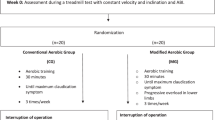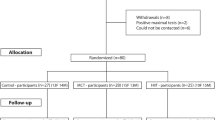Abstract
This study investigated if initial calf muscle training immediately followed by whole body training improved aerobic power and cardiovascular function in peripheral arterial disease (PAD) patients. The training group (n = 10) pursued 8 weeks of high aerobic intensity plantar flexion interval training continued by 8 weeks of high aerobic intensity treadmill training. The control group (n = 11) received advice according to exercise guidelines. Treadmill VO2peak and time to exhaustion increased significantly with 16.8 and 23.4% during the plantar flexion training period while no changes occurred in heart stroke volume (SV). Following treadmill training, SV increased with 25.1% while treadmill VO2peak and time to exhaustion increased 9.9 and 16.1%. Plantar flexion training was effective for increasing treadmill VO2peak and time to exhaustion in PAD patients and amplified the effects of the additional treadmill training, as SV increased and treadmill VO2peak and time to exhaustion improved further. This study suggests that calf muscle training prime PAD patients for cardiovascular adaptations when applying whole body exercise.


Similar content being viewed by others
References
Åstrand PO, Rodahl K, Dahl HA, Strømme SB (2003) Textbook of work physiology. Physiological bases of exercise. Human Kinetics, Leeds
Bassett DR Jr, Howley ET (2000) Limiting factors for maximum oxygen uptake and determinants of endurance performance. Med Sci Sports Exerc 32:70–84. doi:10.1097/00005768-200001000-00012
Bergh U, Sjodin B, Forsberg A, Svedenhag J (1991) The relationship between body mass and oxygen uptake during running in humans. Med Sci Sports Exerc 23:205–211. doi:10.1249/00005768-199102000-00010
Booth FW, Chakravarthy MV, Gordon SE, Spangenburg EE (2002) Waging war on physical inactivity: using modern molecular ammunition against an ancient enemy. J Appl Physiol 93:3–30
Dibski DW, Smith DJ, Jensen R, Norris SR, Ford GT (2005) Comparison and reliability of two non-invasive acetylene uptake techniques for the measurement of cardiac output. Eur J Appl Physiol 94:670–680. doi:10.1007/s00421-005-1343-2
Gardner AW, Poehlman ET (1995) Exercise rehabilitation programs for the treatment of claudication pain. A meta-analysis. JAMA 274:975–980. doi:10.1001/jama.274.12.975
Gardner AW, Katzel LI, Sorkin JD, Bradham DD, Hochberg MC, Flinn WR, Goldberg AP (2001) Exercise rehabilitation improves functional outcomes and peripheral circulation in patients with intermittent claudication: a randomized controlled trial. J Am Geriatr Soc 49:755–762. doi:10.1046/j.1532-5415.2001.49152.x
Gardner AW, Montgomery PS, Flinn WR, Katzel LI (2005) The effect of exercise intensity on the response to exercise rehabilitation in patients with intermittent claudication. J Vasc Surg 42:702–709. doi:10.1016/j.jvs.2005.05.049
Haseler LJ, Lin A, Hoff J, Richardson RS (2007) Oxygen availability and PCr recovery rate in untrained human calf muscle: evidence of metabolic limitation in normoxia. Am J Physiol 293:R2046–R2051
Helgerud J (1994) Maximal oxygen uptake, anaerobic threshold and running economy in women and men with similar performances level in marathons. Eur J Appl Physiol Occup Physiol 68:155–161. doi:10.1007/BF00244029
Helgerud J, Hoydal K, Wang E, Karlsen T, Berg P, Bjerkaas M, Simonsen T, Helgesen C, Hjorth N, Bach R, Hoff J (2007) Aerobic high-intensity intervals improve VO2 max more than moderate training. Med Sci Sports Exerc 39:665–671. doi:10.1249/mss.0b013e3180304570
Hiatt WR (2001) Medical treatment of peripheral arterial disease and claudication. N Engl J Med 344:1608–1621. doi:10.1056/NEJM200105243442108
Hiatt WR, Regensteiner JG, Hargarten ME, Wolfel EE, Brass EP (1990) Benefit of exercise conditioning for patients with peripheral arterial disease. Circulation 81:602–609
Hiatt WR, Wolfel EE, Meier RH, Regensteiner JG (1994) Superiority of treadmill walking exercise versus strength training for patients with peripheral arterial disease. Implications for the mechanism of the training response. Circulation 90:1866–1874
Hiatt WR, Regensteiner JG, Wolfel EE, Carry MR, Brass EP (1996) Effect of exercise training on skeletal muscle histology and metabolism in peripheral arterial disease. J Appl Physiol 81:780–788
Hirsch AT, Haskal ZJ, Hertzer NR, Bakal CW, Creager MA, Halperin JL, Hiratzka LF, Murphy WR, Olin JW, Puschett JB, Rosenfield KA, Sacks D, Stanley JC, Taylor LM Jr, White CJ, White J, White RA, Antman EM, Smith SC Jr, Adams CD, Anderson JL, Faxon DP, Fuster V, Gibbons RJ, Hunt SA, Jacobs AK, Nishimura R, Ornato JP, Page RL, Riegel B (2006) ACC/AHA 2005 Practice Guidelines for the management of patients with peripheral arterial disease (lower extremity, renal, mesenteric, and abdominal aortic): a collaborative report from the American Association for Vascular Surgery/Society for Vascular Surgery, Society for Cardiovascular Angiography and Interventions, Society for Vascular Medicine and Biology, Society of Interventional Radiology, and the ACC/AHA Task Force on Practice Guidelines (Writing Committee to Develop Guidelines for the Management of Patients With Peripheral Arterial Disease): endorsed by the American Association of Cardiovascular and Pulmonary Rehabilitation; National Heart, Lung, and Blood Institute; Society for Vascular Nursing; TransAtlantic Inter-Society Consensus; and Vascular Disease Foundation. Circulation 113:e463–e654. doi:10.1161/CIRCULATIONAHA.106.174526
Klausen K, Secher NH, Clausen JP, Hartling O, Trap-Jensen J (1982) Central and regional circulatory adaptations to one-leg training. J Appl Physiol 52:976–983
Lundgren F, Dahllof AG, Lundholm K, Schersten T, Volkmann R (1989) Intermittent claudication—surgical reconstruction or physical training? A prospective randomized trial of treatment efficiency. Ann Surg 209:346–355. doi:10.1097/00000658-198903000-00016
Myers J, Prakash M, Froelicher V, Do D, Partington S, Atwood JE (2002) Exercise capacity and mortality among men referred for exercise testing. N Engl J Med 346:793–801. doi:10.1056/NEJMoa011858
Richardson RS, Grassi B, Gavin TP, Haseler LJ, Tagore K, Roca J, Wagner PD (1999) Evidence of O2 supply-dependent VO2 max in the exercise-trained human quadriceps. J Appl Physiol 86:1048–1053
Rognmo O, Hetland E, Helgerud J, Hoff J, Slordahl SA (2004) High intensity aerobic interval exercise is superior to moderate intensity exercise for increasing aerobic capacity in patients with coronary artery disease. Eur J Cardiovasc Prev Rehabil 11:216–222. doi:10.1097/01.hjr.0000131677.96762.0c
Saltin B (1985) Hemodynamic adaptations to exercise. Am J Cardiol 55:42D–47D. doi:10.1016/0002-9149(85)91054-9
Shephard RJ, Bouhlel E, Vandewalle H, Monod H (1988) Muscle mass as a factor limiting physical work. J Appl Physiol 64:1472–1479. doi:10.1063/1.341820
Slordahl SA, Wang E, Hoff J, Kemi OJ, Amundsen BH, Helgerud J (2005) Effective training for patients with intermittent claudication. Scand Cardiovasc J 39:244–249. doi:10.1080/14017430510035844
Stewart KJ, Hiatt WR, Regensteiner JG, Hirsch AT (2002) Exercise training for claudication. N Engl J Med 347:1941–1951. doi:10.1056/NEJMra021135
Tan KH, De Cossart L, Edwards PR (2000) Exercise training and peripheral vascular disease. Br J Surg 87:553–562. doi:10.1046/j.1365-2168.2000.01445.x
Tjonna AE, Lee SJ, Rognmo O, Stolen TO, Bye A, Haram PM, Loennechen JP, Al-Share QY, Skogvoll E, Slordahl SA, Kemi OJ, Najjar SM, Wisloff U (2008) Aerobic interval training versus continuous moderate exercise as a treatment for the metabolic syndrome: a pilot study. Circulation 118:346–354. doi:10.1161/CIRCULATIONAHA.108.772822
Wagner PD (2000) New ideas on limitations to VO2max. Exerc Sport Sci Rev 28:10–14
Wang E, Hoff J, Loe H, Kaehler N, Helgerud J (2008) Plantar flexion: an effective training for peripheral arterial disease. Eur J Appl Physiol 104:749–756. doi:10.1007/s00421-008-0826-3
Weitz JI, Byrne J, Clagett GP, Farkouh ME, Porter JM, Sackett DL, Strandness DE Jr, Taylor LM (1996) Diagnosis and treatment of chronic arterial insufficiency of the lower extremities: a critical review. Circulation 94:3026–3049
Wisloff U, Stoylen A, Loennechen JP, Bruvold M, Rognmo O, Haram PM, Tjonna AE, Helgerud J, Slordahl SA, Lee SJ, Videm V, Bye A, Smith GL, Najjar SM, Ellingsen O, Skjaerpe T (2007) Superior cardiovascular effect of aerobic interval training versus moderate continuous training in heart failure patients: a randomized study. Circulation 115:3086–3094. doi:10.1161/CIRCULATIONAHA.106.675041
Womack CJ, Sieminski DJ, Katzel LI, Yataco A, Gardner AW (1997) Improved walking economy in patients with peripheral arterial occlusive disease. Med Sci Sports Exerc 29:1286–1290. doi:10.1097/00005768-199710000-00002
Acknowledgments
The experiments in the present study comply with the current laws of the country in which they were performed.
Conflict of interest statement
The authors declare that no conflict of interest existed in the present study.
Author information
Authors and Affiliations
Corresponding author
Rights and permissions
About this article
Cite this article
Helgerud, J., Wang, E., Mosti, M.P. et al. Plantar flexion training primes peripheral arterial disease patients for improvements in cardiac function. Eur J Appl Physiol 106, 207–215 (2009). https://doi.org/10.1007/s00421-009-1011-z
Accepted:
Published:
Issue Date:
DOI: https://doi.org/10.1007/s00421-009-1011-z




